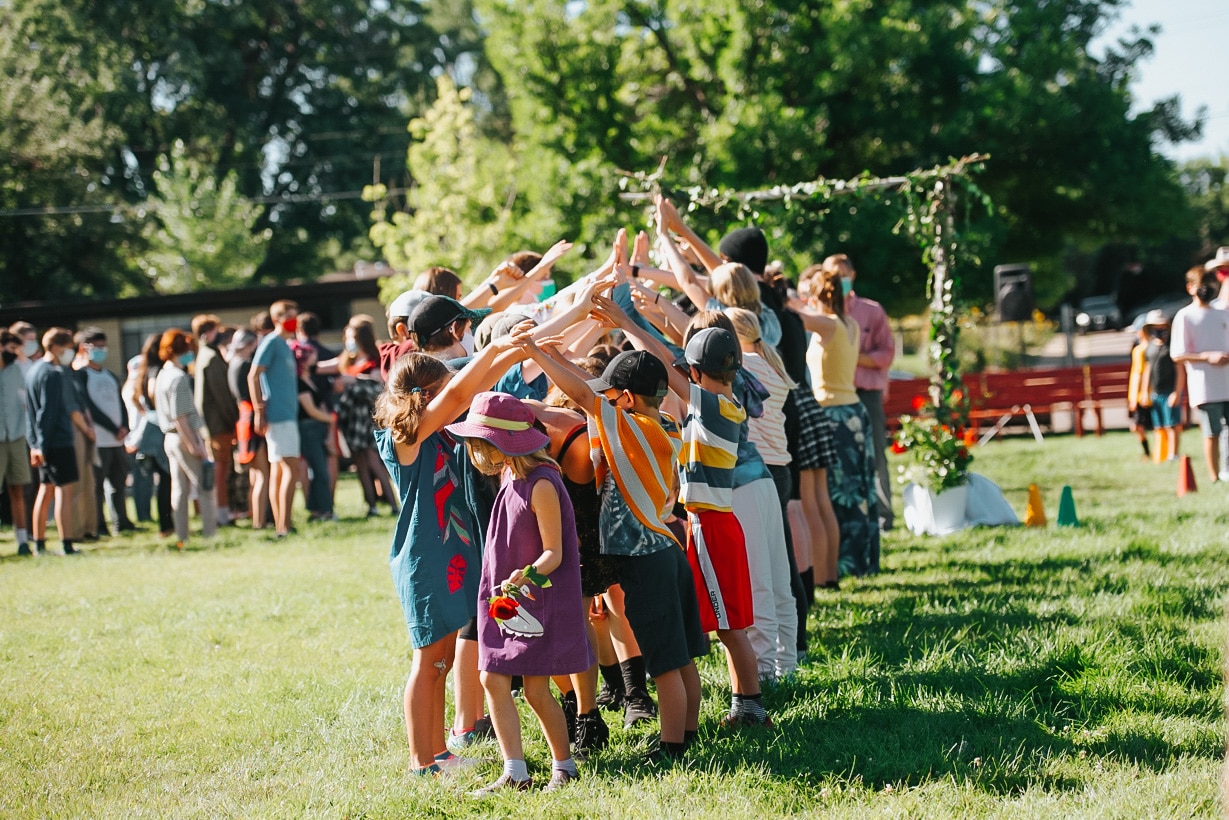The sun shines behind a row of seniors, sitting confidently on benches facing a semicircle of students and teachers with eager, expectant faces. 8th graders stand in the wings, some shift from foot to foot, others try to remain standing, straight and ready. 1st graders nuzzle or squirm on their parents’ laps. A vase of roses lies center stage before the seniors.
Every year we begin and end the year with the Rose Ceremony, an event that marks the transition from one stage of life to another. Foundational to Waldorf education is the understanding of human development and its phases. One principle of human development is the seven year phases of life: birth to 7, 7 to 14, 14, to 21. In the Rose Ceremony, we see each of these phases represented as the kindergartener enters 1st grade, the 8th grader enters high school, and the senior enters adulthood (though it should be noted that they’ve got 3 more years until age 21). Three ideals live within each seven year period: goodness, beauty, and truth.
From when a child is born, up through our early childhood program, the child is most nourished by a sense that the world is good. We cultivate this sense of goodness through the loving affection of the teachers, through stories, and through the very daily environment the children experience with their senses. The teacher carries on the parents’ loving gaze and the constant devotion to the child’s well being. Hugs each morning, snuggles on the rocking chair, a nice back rub when settling down for a nap all let the child know that they are loved and in a good, safe place.
Rudolf Steiner describes how during the first seven years the young child nearly “breathes in the whole character of the environment.” Largely unconsciously, the young child directly experiences the physical world and the moral quality behind it. During these years the child unconsciously seeks to develop their lower senses: touch, smell, balance, movement, and life. It is sufficient to say that the child has an innate drive to explore with these senses because they develop a foundational understanding of the world around them, and through that experience of the world, they experience themselves. When we create an environment with a natural diversity of sense experiences, then this innate drive is satisfied, and they experience the world as good. In this way, the kindergarten teacher is like the gardener. The gardener creates an environment that encourages the plant to grow by providing the right soil, the right amount of water, and the right amount of sunlight. The seed was always seeking to grow, this is innate, and the gardener simply helps the plant fulfill its destiny.
When the child enters first grade, Steiner says, “The next seven years are spent not so much breathing in the environment, but listening to what it has to say.” In these years between first and eighth grade, the teacher is a mediator between the child and the world. This is why storytelling is so important in our curriculum. The spoken and written word help guide the students through an understanding of the world, and through the word, and through the teachers, the students develop a feeling that the world is beautiful. The world may not always be good, and this is something that the teacher helps reveal as well, but in the world beauty persists. The teacher’s relationship with the world helps the student develop a healthy relationship with the world. Without a relationship, the world is incoherent and causes anxiety. Through the teacher’s artistic teaching, the student sees that the world is ordered, is coherent, and that they belong.
Of course, the natural authority of the adult erodes with time in order to make room for the authority of the students themselves. High school is when the student can no longer experience truth through the teacher, but only through their own conscious thinking activity. The students must use their physical senses to observe without judgment and to think clearly about these experiences in order to develop concepts free from external influences. What the teacher does provide is an environment and a means for investigating the “riddles of the world,” as Steiner refers to them. The teacher helps “awaken within them an extraordinarily great interest in the world outside of themselves.” The student should have confidence that their teacher has access to the answer, but the teacher guides rather than imposes.
Through these three phases, we help cultivate in our students the ability to not only sense goodness, beauty, and truth, but also to be bearers of them out in the world. When they stand on the stage and receive their high school diploma they look out into the world with confidence and love.
Written by Education Director, Vernon Dewey
To learn more about the Rose Ceremony and how Waldorf education brings truth, beauty, and goodness into the classroom, you can listen to our podcast episode covering this topic here.

